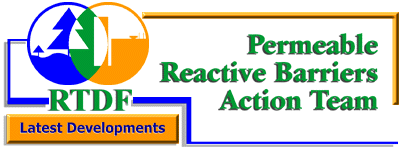 |
Chlorinated Solvents |
||||||
|
|
|
||||||
|
|
|||||||
 |
Chlorinated Solvents |
||||||
|
|
|
||||||
|
|
|||||||
|
Installation Date: Contaminants: Reactive Media: Cost: Construction: Point of Contact: |
|
|
In 1998, Atomic Energy of Canada, Ltd. installed a permeable reactive barrier (PRB) system at Chalk River Laboratories, Ontario, to mitigate the discharge of a ground-water plume of radioactive strontium (Sr-90) into a wetland. The PRB consists of a steel cut-off wall, a curtain of reactive media to treat contaminated ground water, and a subsurface bypass drainage system for non-contaminated, overlying ground water. The reactive media used at this site is a 153.4-yd3 granular curtain of 14 × 50 mesh clinoptilolite (zeolite), which was positioned in front of the cut-off wall. The cut-off wall is 98.4 ft in length and extends 31.2-39.4 ft into till or to contact the bedrock. The reactive material was situated in front of the cut-off wall and is 6.6 ft in length, 36.1 ft in width, and 18 ft deep. The PRB extends from just below grade to about 20 ft below the surface. The total cost of the PRB was approximately $300,000. The leading edge of this plume, which is about 20 ft wide, is located within the deep portions of a 40-ft-thick aquifer. It has migrated about 1,400 ft downgradient of its initial source area. The concentration of Sr-90 in the ground water ranges from 0.1-100 Becquerel (Bq)/L. (A Becquerel is a unit of radioactivity in the International System of Units.) In the early 1950s, a pilot plant was operated at Chalk River for the purpose of decomposing and reducing the volumes of ammonium nitrate solutions containing mixed fission products. Some of these solutions were released into pits lined with crushed limestone. The site is underlain by sands derived from granitic gneiss. The saturated thickness of the sandy aquifer ranges in thickness from 16.4-42.6 ft. The hydraulic conductivity of the aquifer is on the order of .02 to .04 ft/min. This facility treats 1.51 × 107 L per year (7.6 gpm) of contaminated ground water, while diverting 107 L per year of clean ground water, which would otherwise enter the PRB. In the past two years, the wall-and-curtain has prevented the discharge of 2.7 × 109 Bq of Sr-90 into the adjacent wetland. Ground-water outflow meets Canadian drinking water quality guidelines. This PRB has retained virtually 100% of the contaminant since it was built in 1998. Monthly sampling is ongoing. One problem that has been identified is that the steel sheet pilings were not grouted to the bedrock. Leakage beneath the steel cut-off wall is at a rate of 0.8 gpm. The seriousness of this problem is mitigated by the fact that flow can be controlled. If this problem is repaired, performance monitoring over the long term will be simplified, and this would improve confidence that contaminants are not reaching the wetland.
Three lessons were learned during the construction phase of the PRB. The first was that the team should have sand-packed more of the dewatering wells with reactive materials. Secondly, the team should have provided available information about the aquifer to all of the subcontractors, rather than rely on the contractor to do this. Finally, the roots should have been cleared before construction, so that they would not delay or pose problems during sheet pile installation. |
![]()
Sponsored by the Technology Innovation Program
Date Last Modified: May 30, 2001